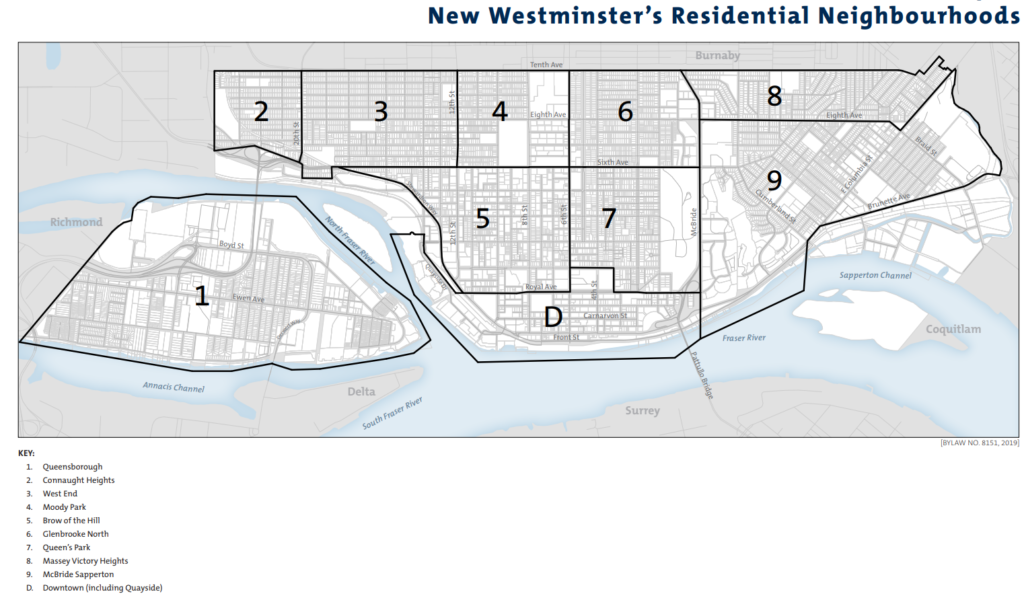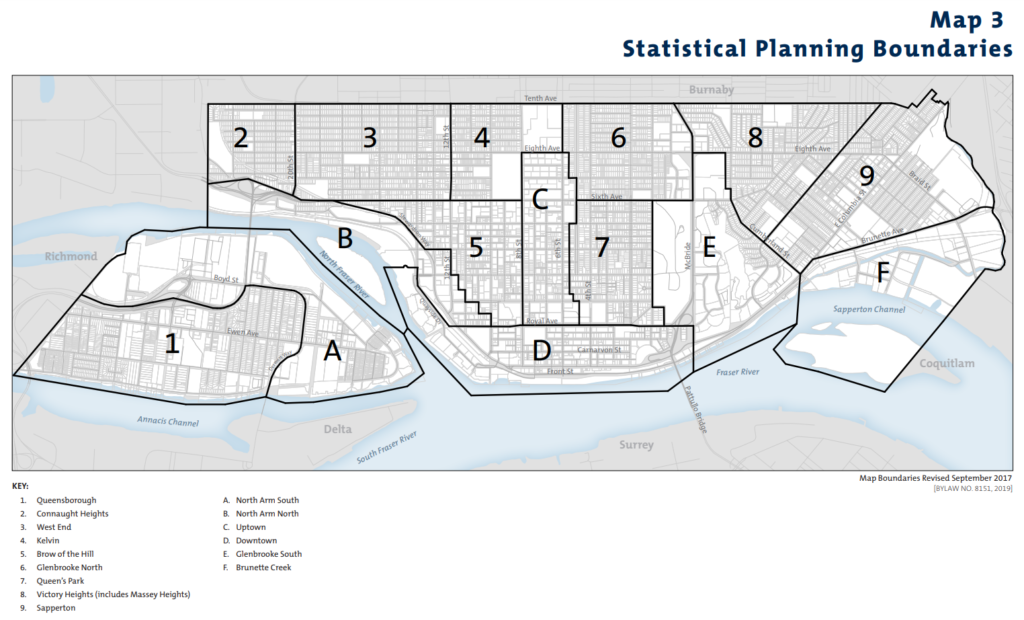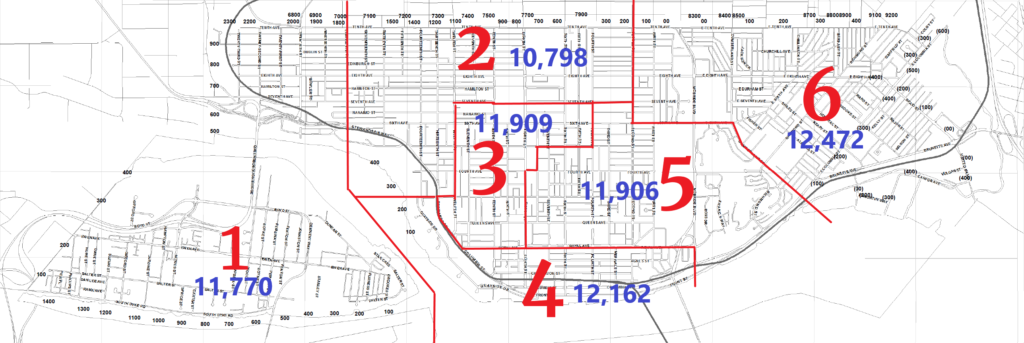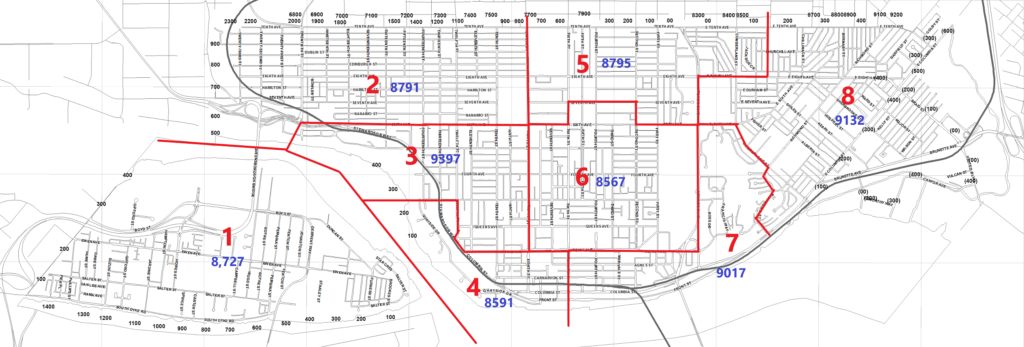KJ Asks: Hey Pat, why don’t we have wards in New Westminster? Is that the only way we can get a Councillor from Queensborough?
Your timing is a little off. The discussion of a ward system usually come up some time during municipal elections. It is often raised by a neighbourhood group that feels it gets less benefit from City Council largess than it deserves (so, pretty much every neighbourhood), with the suspicion that a ward system would help.
In many jurisdictions in Canada, municipal councilors are not elected “at large” to represent the entire City like in New West, but are elected to represent a single neighbourhood or group of neighbourhoods called “wards”. Instead of voting for your favourite six from across the city, you vote for one from your neighbourhood only. For some reason, this is not common in British Columbia, and excepting Lake County (which has 4 wards and two “at large” councilors, to the chagrin of some, there are none in BC. Surrey is looking at it, though.
Section 53 of the Local Government Act makes it possible for a City to pass a bylaw to switch from the default “at large” system to a “neighbourhood constituency” system, with no specific requirement for a referendum to make the switch, though the Provincial Government does need to sign off on the change. Running a ward-based election is a little more complicated (efforts need to be taken to make sure voters are voting in the right neighbourhood) and potentially a little more expensive, but there is no technical reason I can find why a City couldn’t do it.
There have been some suggestions made about why cities shouldn’t do it. Mostly, it is argued that the ward system actually reduces the diversity of representation and provides more power to established political systems/parties. Those are balanced perhaps by arguments that local neighbourhoods may have more direct representation, or at least the majority of the people in that neighbourhood do. I guess there has been enough written about this by others that I’ll leave it to you to decide which system is better, and that is not the question you asked.
What I’m more interested in is what wards might look like in New West if we went that way. In theory, we would try to have balanced population in each ward and do our best to keep traditional neighbourhoods whole. Having 6 council positions and 71,000 residents in the last Census, that would mean about 11,830 residents per ward. The problem is, we have 6 Council positions and something between 10 and 15 neighbourhoods, depending on how you choose to chop them up. Even the City’s OCP, there are two “neighbourhood maps”, neither of which align with the current list of Residents Associations. So there is definitely some ambiguity going in:

So I decided to have some fun with the 2016 Census data, which breaks the City into something like 92 census tracts. The tool census mapper by Jens von Bergmann makes it easy to look up various census data at different scales, so I relied on that data. I used to be a GIS guy, but don’t really have GIS tools at home to do this eloquently, so I took the data from census mapper and did a little traditional pen and paper work (I knew I would finally use that Geography degree!) and simple drawing software to sketch out what wards (if New West had them) might look like.
Gerrymandering aside, my basic first task was to think of how to clump neighbourhoods. My first attempt was to start at each end (Queensborough and Sapperton) and draw a ward for each of them that expanded to get as close as possible to the magic 11,833 number within the existing census tracts (71,000 residents divided by 6). Clumping downtown and Quayside together made sense to me, and the rest I just tried to draw lines that split up the middle third by population without too many squiggles in lines and trying to keep traditional neighbourhoods intact. It was not easy. Here are my 6 wards with the 2016 population:
One of the surprising things to come out of this exercise was to see how populated the Brow of the Hill is, even compared to Downtown and the Quayside or Sapperton. Alternately, Queens Park would need to append all of Victoria Hill, Fraserview and a significant chunk of the Brow to meet the population threshold required to fill a Ward.
One thing people may not realize that Section 118 of the Community Charter says a City of New Westminster’s size should have 8 City Councilors. Apparently, when New West hit the 50,000 population threshold about 20 years ago, they had a plebiscite about adding to the size of government, and you can all guess how that went. But if we were to shift to a ward system, it may be a good time to review what a Council of 8 would look like so I did a bit of a map with wards of ~8,875 residents:
In some ways, this works a little better. Queensborough would have a case for its own ward, and clumping Fraserview/Victoria Hill with the east end of Downtown makes more sense to me than clumping it with Queens Park.
Of course, population is growing faster in some neighbourhoods (Queensborough and Downtown) faster than others (Connaught Heights actually shrunk in population between the last two censuses), so future shifts to a ward system would shift a little to reflect this. I also wonder how we would ever create a transparent and fair ward districting system, because if former-GIS-guy City Councillor doing it using Microsoft paint based on 5 year old Census data is not the perfect system, I’m not sure what is.
There is also the small problem of my being the second most popular Councillor in the Brow of the Hill.
As for the Queensborough question, I would make two points. First, there is nothing in the Local Government Act that says a representative of a ward needs to live in that ward, though it would surely be an advantage electorally. Even without a ward system, I would suggest for a person from Queensborough to get on Council, they would need to run. Going back through the last 4 elections, 46 (!) people have run for City Council in New West, some multiple times. Only one of those people (to the best of my memory – I stand to be corrected here) lived in Queensborough. That’s not good odds. Alternately, looking back at the last three elections for School Board Trustee, 32 candidates have run, only one person from Queensborough has run, and she won handily in her first attempt. So the odds are good?
Many people have no idea that for the first 35 years of its life, New Westminster operated under a ward system.
In 1860, when the Municipal Council was established, there were 4 wards and 7 councilors. The following year, 2 councilors were added. In 1863 there were 3 new wards and 3 more councilors, bringing the total to 7 wards and 12 councilors! The Municipality Act of 1872 brought it back to 3 wards and 7 councilors, and then finally in 1895 New Westminster (then under the New Westminster Act and separate charter, like Vancouver is now), changed to its current at-large system.
I had feeling someone was going to fill in the history here for me. When they had the 12 Councilors, surely this was the larger New Westminster District, not the City we think of now?
Nope. It was the City – municipal councilors had no jurisdiction over the District. However, neither Council nor Mayor were paid, so while meetings were larger and sometimes longer, there weren’t many negatives about a larger Council.